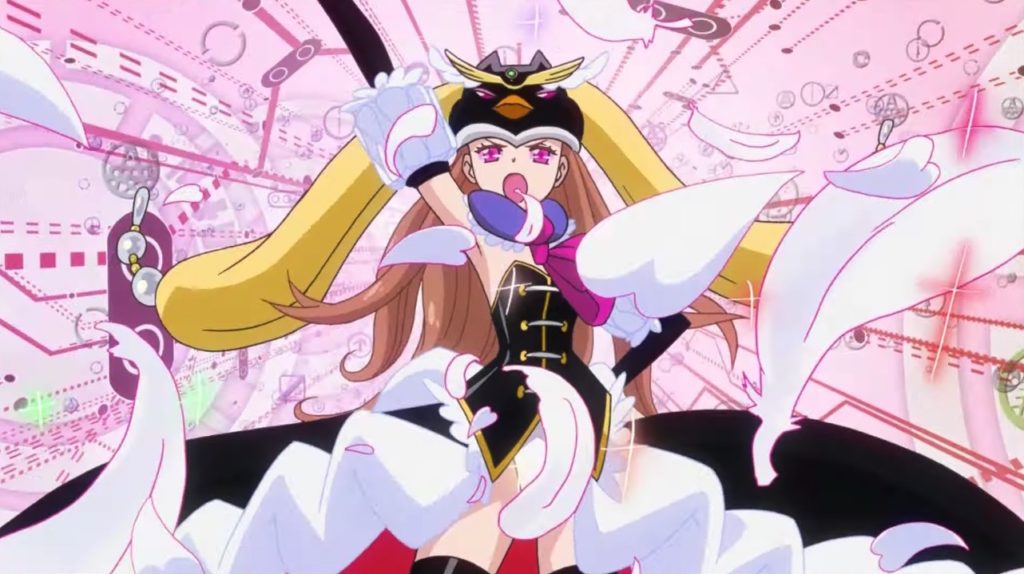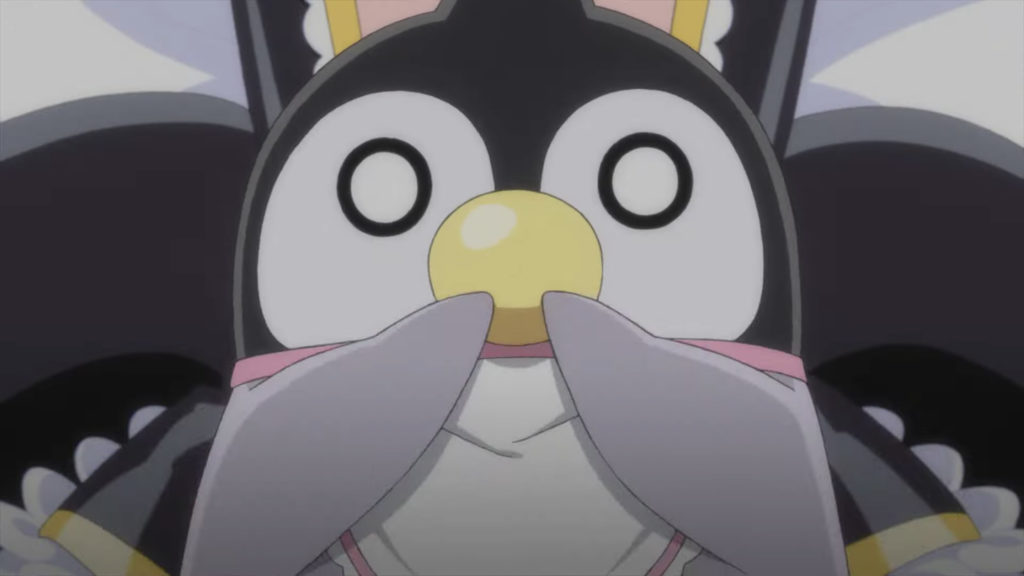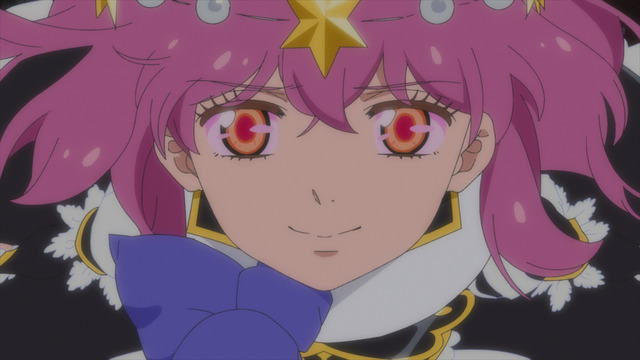Re:cycle Penguindrum
October 9, 2022 · 0 comments
By Andrew Osmond.

In Penguindrum, a dorky penguin hat – that’s a hat that looks like a penguin, not one made out of penguins – brings a beautiful girl back to life. This miracle starts an adventure that’s insanely odd even by the standards of anime. The girl is Himari Takakura, the angelic sister of brothers Shoma and Kanba, who are devoted to her with alarming intensity. They’re devastated by her death – she collapses at a Tokyo aquarium – elated by her miracle recovery, and dumbfounded by what happens next.
Himari wears the penguin hat, and turns into the sexy dominatrix-goddess of a psychedelic dimension, mercilessly ordering the boys to discover the fabled Penguindrum. Remember, she’s their little sister. Only anime could envisage an incestuous Yellow Submarine fantasy quite so blithely.
“Penguins,” commented director Kunihiko Ikuhara in the Penguindrum Guide Book, “have been like mascot characters for multiple generations. The reason for that is probably because, as animals, they are ‘out there’. We have dogs and cats as part of our daily life, and most other pets are mammals like them, but penguins are birds. Except they’re not like other birds. They dive in the water. It’s like they are almost their own special penguin animal family. And isn’t great that there’s this sense of they can’t go anywhere. It’s like: I can’t fly, but I can’t stay underwater forever, either. So where do I belong?”

Like many anime, Penguindrum starting from an utterly silly premise and slowly gets you to take it seriously. It begins as an absurd comedy, then twists into a lethally sharp corkscrew. Like other anime, it has extreme lurches from low-brow slapstick to operatic melodrama; it uses arch spoofs of anime classics and clichés, before transcending them. Then there’s the psycho-thriller sit-com strand. Another of the main characters is a worryingly obsessive-psychotic schoolgirl who fixates on an older man, tunnelling under his house and snuggling beneath his floorboards. Brrr…
Penguindrum initially has you watching just for the scene-stealing magic penguins – what, I didn’t mention them? – as they lark around the screen. However, the show is addictive in the long term because you never know what it’ll turn into next. For example, for a long time it looks like Himari will be a girly cipher when she’s not in Fearsome Goddess mode. But then a whole Alice-style fantasy episode fills out her character and suggests steel under her cutesy exterior.
“It all starts with [the designer] Lily Hoshino,” comments Ikuhara. “Do you see that the designs she draws, and the details, are actually a parody of commonplace tropes in our generation, but in a decadent fashion? It’s a pleasure for the eyes. Things like the princess’s clothes are grotesque, but also have a beauty and grace. I mean that in a good way!”

Hardcore anime fans will be lured in by Ikuhara, sometime director of Sailor Moon and creator of Revolutionary Girl Utena. The same fans will appreciate the running gags about yesteryear anime like Sailor Moon – Himari gets her own once-an-episode magic girl transformation! – and Rose of Versailles, re-envisioned as a cardboard fantasy of the schoolgirl psycho.
There are allusions to Kenji Miyazawa’s Night on the Galactic Railroad, a classic Japanese fantasy, written as a requiem for its author’s dead sister, and discussed in more detail elsewhere on this blog. There’s also an overt reference to a more recent fantasy fable, “Super Frog Saves Tokyo” by Haruki Murakami – you could imagine Penguindrum taking place in its world.
The Brain’s Base studio gives the anime its own identity through stylised running motifs. The crowds of ‘extras’ on Tokyo’s streets are faceless stick-figures. Subway stations are abstracted to signboards and mechanised ticket barriers. Scary cherubs scamper through neon screens like Powerpuff Girls.

(Minor spoilers follow.) The series also has a direct reference to a traumatic event in Japan’s post-war history, revealed at the midway point. For Japanese viewers, it would have had an impact comparable to that halfway reveal in Makoto Shinkai’s Your Name… which was also, of course, reflecting on a trauma in Japanese history.
Looking back on Penguindrum in Eureka magazine in 2017, Ikuhara confessed that it was a work not so much of calculated provocation, but undertaken with an understanding that it would attract criticism in some quarters, inspired to some extent by the shock and horror of the ‘3.11’ disaster, a hat trick of incidents in which an earthquake led to a tidal wave, which itself caused a nuclear accident. The Tohoku earthquake/tsunami, and the attendant Fukushima reactor crisis, were topics to which Ikuhara would later return in 2019’s Sarazanmai, inspired not only by the incidents themselves, but by the fact the fact that they hit Japan at the end of the “lost decades” – 20 years of decline and stagflation, roughly approximating with Ikuhara’s own career, as he rose to fame in the early seasons of Sailor Moon.
“Penguindrum was a work I felt I had to make, regardless of the consequences, so that event was something of a trigger. Still, directly taking that up as a subject would have been cause for misunderstanding. Using the subject itself would have been sinful, so there would, of course, have been some people criticising it, saying how could I take such a topic and exploit it for commercial gain. I think such criticisms were, and still are, being directed at the work. Even so, we were just barely able to make it because there were some people who believed in it. With some details [of Tohoku] taken into the work, it wouldn’t have been unusual for it to cause a negative reaction, so I was very careful in how I dealt with the surrounding situation.”
Like Your Name, the second half of Penguindrum (the matter of the second film in the sequel/remake) is very different from the first. There’s non-consenting bondage, really nasty things done to kids, and more heavy-duty allusions to fairy-tales, Miyazawa mixed with Hans Christian Andersen. Among other things, you’ll find out why Penguindrum is probably the only work apart from Fight Club to have cute cartoon penguins and an ‘18’ from the BBFC. Okay, it’s probably the bondage.
Eventually, it becomes impossible to draw lines between the characters’ “reality” and the realm of dreams and symbols. The finale starts as anaction-movie climax, packed with bombs and bullets; then it segues into a bucket of viscous cartoon symbolism. But beneath all that, there’s a fairy story rooted in reality, a moving tale of lost children.
The Penguindrum movie Re: cycle of the Penguindrum, is screening at this year’s Scotland Loves Anime.
Leave a Reply